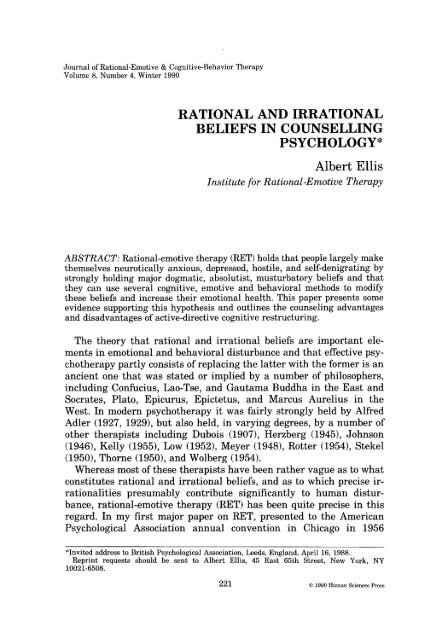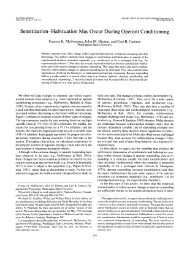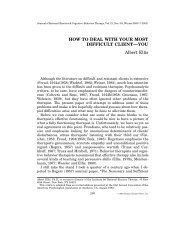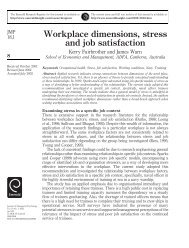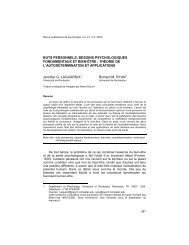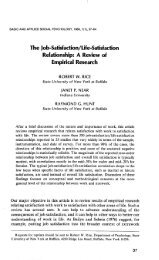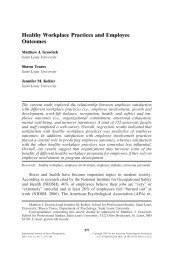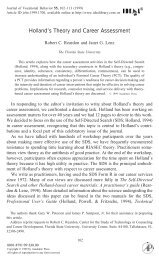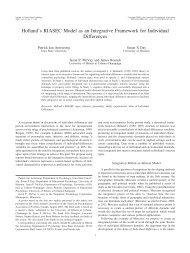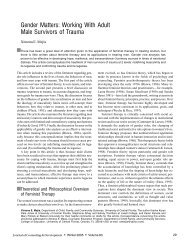Rational and irrational beliefs in counselling psychology
Rational and irrational beliefs in counselling psychology
Rational and irrational beliefs in counselling psychology
Create successful ePaper yourself
Turn your PDF publications into a flip-book with our unique Google optimized e-Paper software.
Journal of <strong>Rational</strong>-Emotive & Cognitive-Behavior TherapyVolume 8, Number 4, W<strong>in</strong>ter 1990RATIONAL AND IRRATIONALBELIEFS IN COUNSELLINGPSYCHOLOGY*Albert EllisInstitute for <strong>Rational</strong>-Emotive TherapyABSTRACT: <strong>Rational</strong>-emotive therapy (RET) holds that people largely makethemselves neurotically anxious, depressed, hostile, <strong>and</strong> self-denigrat<strong>in</strong>g bystrongly hold<strong>in</strong>g major dogmatic, absolutist, musturbatory <strong>beliefs</strong> <strong>and</strong> thatthey can use several cognitive, emotive <strong>and</strong> behavioral methods to modifythese <strong>beliefs</strong> <strong>and</strong> <strong>in</strong>crease their emotional health. This paper presents someevidence support<strong>in</strong>g this hypothesis <strong>and</strong> outl<strong>in</strong>es the counsel<strong>in</strong>g advantages<strong>and</strong> disadvantages of active-directive cognitive restructur<strong>in</strong>g.The theory that rational <strong>and</strong> <strong>irrational</strong> <strong>beliefs</strong> are important elements<strong>in</strong> emotional <strong>and</strong> behavioral disturbance <strong>and</strong> that effective psychotherapypartly consists of replac<strong>in</strong>g the latter with the former is anancient one that was stated or implied by a number of philosophers,<strong>in</strong>clud<strong>in</strong>g Confucius, Lao-Tse, <strong>and</strong> Gautama Buddha <strong>in</strong> the East <strong>and</strong>Socrates, Plato, Epicurus, Epictetus, <strong>and</strong> Marcus Aurelius <strong>in</strong> theWest. In modern psychotherapy it was fairly strongly held by AlfredAdler (1927, 1929), but also held, <strong>in</strong> vary<strong>in</strong>g degrees, by a number ofother therapists <strong>in</strong>clud<strong>in</strong>g Dubois (1907), Herzberg (1945), Johnson(1946), Kelly (1955), Low (1952), Meyer (1948), Rotter (1954), Stekel(1950), Thorne (1950), <strong>and</strong> Wolberg (1954).Whereas most of these therapists have been rather vague as to whatconstitutes rational <strong>and</strong> <strong>irrational</strong> <strong>beliefs</strong>, <strong>and</strong> as to which precise <strong>irrational</strong>itiespresumably contribute significantly to human disturbance,rational-emotive therapy (RET) has been quite precise <strong>in</strong> thisregard. In my first major paper on RET, presented to the AmericanPsychological Association annual convention <strong>in</strong> Chicago <strong>in</strong> 1956*Invited address to British Psychological Association, Leeds, Engl<strong>and</strong>, April 16, 1988.Repr<strong>in</strong>t requests should be sent to Albert Ellis, 45 East 65th Street, New York, NY10021-6508.221 9 1990 Human Sciences Press
Albert Ellis 223to feel anxious, depressed, <strong>and</strong> worthless. When they believe "Othersmust treat me considerately, lov<strong>in</strong>gly <strong>and</strong> fairly" <strong>and</strong> when it appearsthat others do not follow this comm<strong>and</strong>, they tend to feel angry, enraged,<strong>and</strong> v<strong>in</strong>dictive. When people believe "Life should be easy <strong>and</strong>conditions must provide me with what I need immediately <strong>and</strong> pa<strong>in</strong>lessly,"<strong>and</strong> when life is harder than what they dem<strong>and</strong>, they oftenfeel <strong>in</strong>tolerant of frustration, self-pity, <strong>and</strong> depression.Although I formulated the specific RET theory that musturbatory<strong>beliefs</strong> significantly contribute to neurotic disturbance <strong>in</strong> the early1970s, as far as I know, no particular research has been done to specificallysee whether psychotherapy <strong>and</strong> counsel<strong>in</strong>g clients have dem<strong>and</strong>s,comm<strong>and</strong>s <strong>and</strong> <strong>in</strong>sistences <strong>and</strong> whether these actually are correlatedwith their disturbed feel<strong>in</strong>gs <strong>and</strong> behaviors. Know<strong>in</strong>g I was togive this paper to the British Psychological Society, I decided to makea prelim<strong>in</strong>ary study check<strong>in</strong>g on this hypothesis. I monitored 100 ofmy sessions with regular clients, 50 with males <strong>and</strong> 50 with females,to see what self-defeat<strong>in</strong>g feel<strong>in</strong>gs they brought up dur<strong>in</strong>g these sessions<strong>and</strong> what musturbatory <strong>beliefs</strong> they acknowledged as concomitantsof these <strong>beliefs</strong>.RESULTSThe ma<strong>in</strong> f<strong>in</strong>d<strong>in</strong>gs of my pilot study are shown <strong>in</strong> Table 1. The threema<strong>in</strong> self-defeat<strong>in</strong>g feel<strong>in</strong>gs that are commonly p<strong>in</strong>po<strong>in</strong>ted dur<strong>in</strong>gRET sessions are (1) anger at other people (<strong>in</strong>clud<strong>in</strong>g hostility, rage,fury, v<strong>in</strong>dictiveness, <strong>and</strong> violence); (2) anger, low frustration tolerance,<strong>and</strong> self-pity about discomfort or lack of comfortable conditions;<strong>and</strong> (3) self-down<strong>in</strong>g or feel<strong>in</strong>gs of worthlessness accompanied by (a)<strong>in</strong>adequacy feel<strong>in</strong>gs <strong>and</strong>/or (b) dire needs for approval. When I checkedthe <strong>in</strong>cidence of <strong>irrational</strong> musts <strong>and</strong> absolutist dem<strong>and</strong>s acknowledgedmy clients as concomitants of their disturbed feel<strong>in</strong>gs, I foundthat my sample of 100 acknowledged 77 musts as concomitants of angerat others, 101 musts as concomitants of discomfort-oriented anger,low frustration tolerance, <strong>and</strong> self-pity, <strong>and</strong> 195 musts associated withself-down<strong>in</strong>g <strong>and</strong> feel<strong>in</strong>gs of worthlessness.This was only a little surpris<strong>in</strong>g because although I expected virtuallyall my regular clients to br<strong>in</strong>g self-denigrat<strong>in</strong>g feel<strong>in</strong>gs to theirsessions, I did not predict that the great majority of them would alsobr<strong>in</strong>g up almost two anger <strong>and</strong>/or low frustration tolerance problems<strong>in</strong> a s<strong>in</strong>gle, r<strong>and</strong>omly chosen session.
224 Journal of <strong>Rational</strong>-Emotive & Cognitive-Behavior TherapyTable 1Frequency of Self-defeat<strong>in</strong>g Feel<strong>in</strong>gs <strong>and</strong> Accompany<strong>in</strong>gIrrational Musts Acknowledged by 100 <strong>Rational</strong>-EmotiveTherapy ClientsSelf-defeat<strong>in</strong>gFeel<strong>in</strong>gMa<strong>in</strong> Irrational Musts<strong>and</strong> Absolutist Dem<strong>and</strong>sNumber of ClientsAcknowledg<strong>in</strong>g(N= I O0)Anger at perceived<strong>in</strong>justicesAnger atfrustrations <strong>and</strong><strong>in</strong>conveniencesTotal <strong>irrational</strong> mustsother peopleAnger <strong>and</strong> lowfrustration toleranceabout discomfortSelf-pity <strong>and</strong> lowfrustration toleranceabout discomfortPeople must treat mefairly <strong>and</strong> justlyPeople must treat otherpeople fairly <strong>and</strong> justlyPeople must not frustrateor <strong>in</strong>convenience mePeople must not be<strong>in</strong>competent orirresponsibleaccompany<strong>in</strong>g anger atI must experience lessdiscomfort than I nowfeelI must experience morecomfort than I now feelOther people mustexperience less discomfortthan they now feelI must live <strong>in</strong> a worldwith much more certa<strong>in</strong>ty<strong>and</strong> orderI must not be deprived,hassled, or criticizedI must have thesatisfactions that othershave4342197756265563
Albert Ellis 225Table 1 (CoRt<strong>in</strong>ued)Self-defeat<strong>in</strong>gFeel<strong>in</strong>gMa<strong>in</strong> Irrational Musts<strong>and</strong> A bsolutist Dem<strong>and</strong>sNumber of ClientsAcknowledg<strong>in</strong>g(N= I O0)Total <strong>irrational</strong> musts accompany<strong>in</strong>g low frustrationtolerance about discomfort<strong>in</strong>g conditions 101Self-down<strong>in</strong>g <strong>and</strong> I must be competent <strong>and</strong>feel<strong>in</strong>gs of successful 58<strong>in</strong>adequacyI must be <strong>in</strong> control of myfeel<strong>in</strong>gs, not too upset 21I must act perfectly,greatly, nobly 19I must be strong,discipl<strong>in</strong>ed, hard-work<strong>in</strong>g 9I must be moral <strong>and</strong>ethical 8I must be k<strong>in</strong>der <strong>and</strong>more lov<strong>in</strong>g 6Self-down<strong>in</strong>g <strong>and</strong>need for approvalI must be seen <strong>and</strong>accepted by others ascompetent 32I must be approved <strong>and</strong>loved by significantothers 25I must be seen <strong>and</strong>accepted by others as anice person 17Total number of <strong>irrational</strong> musts accompany<strong>in</strong>gself-down<strong>in</strong>g feel<strong>in</strong>gs 195Grant Total of Irrational Musts 373My second mild surprise was that, on the whole, my clients broughtup a total of 373 problems, with accompany<strong>in</strong>g major <strong>irrational</strong> <strong>beliefs</strong>,<strong>in</strong> only one hundred sessions. This was probably because, as arout<strong>in</strong>e homework assignment, I tell virtually all my clients to make
226 Journal of <strong>Rational</strong>-Emotive & Cognitive-Behavior Therapybrief notes dur<strong>in</strong>g the week about the specific emotional <strong>and</strong> behavioralproblems they experience <strong>and</strong> to look for the <strong>irrational</strong>itiesaccompany<strong>in</strong>g these disturbances <strong>and</strong> br<strong>in</strong>g them up for discussiondur<strong>in</strong>g their next session. So that they often br<strong>in</strong>g up multiple problemsdur<strong>in</strong>g sessions is to be expected. Nonetheless, it is <strong>in</strong>terest<strong>in</strong>g tonote that my regular RET clients very often plague themselves withseveral major emotional problems; <strong>and</strong> that even as they are apparentlyresolv<strong>in</strong>g one of them (e.g., anger at perceived <strong>in</strong>justices), theyeasily go back to creat<strong>in</strong>g another one (e.g., anger at frustrations <strong>and</strong><strong>in</strong>conveniences).The fact that I found so many <strong>irrational</strong> shoulds, oughts, <strong>and</strong> mustsaccompany<strong>in</strong>g my clients' self-defeat<strong>in</strong>g feel<strong>in</strong>gs is, of course, hardlysurpris<strong>in</strong>g--s<strong>in</strong>ce I assume that their feel<strong>in</strong>gs <strong>and</strong> <strong>beliefs</strong> are correlated(<strong>and</strong> that the latter partly "cause" the former). With this theory(or prejudice!) I seek, <strong>and</strong> <strong>in</strong>variably f<strong>in</strong>d, the musts that supposedlyunderlie their self-defeat<strong>in</strong>g feel<strong>in</strong>gs. My clients, who are also taughtRET theory <strong>and</strong> practice, are similarly prejudiced. They also may caterto may approval. So they almost always agree that they actuallyemploy the musts I <strong>and</strong> they discover. When they occasionally disagreedwith me <strong>in</strong> the course of this study, I did not <strong>in</strong>clude theirmusts <strong>in</strong> my f<strong>in</strong>d<strong>in</strong>gs.If my little study reflects therapeutic reality, a few more tentativeconclusions may be drawn from observation of Table 1:1. Clients are basically gr<strong>and</strong>iose <strong>and</strong> unrealistic. They not only rationallydesire but also <strong>irrational</strong>ly comm<strong>and</strong> that others must treatthem justly <strong>and</strong> considerately, that discomfort <strong>and</strong> lack of pleasurehave to be abolished, <strong>and</strong> that they have got to perform competentlyor outst<strong>and</strong><strong>in</strong>gly <strong>and</strong> absolutely need others' approval <strong>in</strong> order to acceptthemselves. With Jehovian dem<strong>and</strong>s like these what are theirchances of not steadily upsett<strong>in</strong>g themelves?2. Clients more often tend to enrage themselves aga<strong>in</strong>st people who areperceived as treat<strong>in</strong>g them unjustly than aga<strong>in</strong>st those who simplyfrustrate them. As I have proposed before (Ellis, 1987) because theysee that dem<strong>and</strong><strong>in</strong>g total convenience <strong>in</strong> life is blatantly <strong>irrational</strong><strong>and</strong> don't see that dem<strong>and</strong><strong>in</strong>g justice is subtly (but still just as profoundly)<strong>irrational</strong>, they <strong>in</strong>sist on the latter more than the former<strong>irrational</strong> belief.3. Clients seem to be more frequently disturbed about experienc<strong>in</strong>g discomfortthan about not experienc<strong>in</strong>g more comfort. This f<strong>in</strong>d<strong>in</strong>g goesalong with that of several <strong>in</strong>vestigators who have found that depres-
Albert Ellis 227sion is a concomitant of people's experienc<strong>in</strong>g a number of relativelym<strong>in</strong>or hassles (Lazarus & Folkman, 1984).4. The dire needs to be competent <strong>and</strong> to be approved by significantothers are strong components of self-down<strong>in</strong>g <strong>and</strong> feel<strong>in</strong>gs of worthlessness.These two musts seem to be <strong>in</strong>terrelated--s<strong>in</strong>ce clients dem<strong>and</strong>competence <strong>in</strong> order to be approved <strong>and</strong> often behave anxiously<strong>and</strong> <strong>in</strong>competently when they th<strong>in</strong>k they are not approved. But asB<strong>and</strong>ura (1977) has shown, self-efficacy can also be a dem<strong>and</strong> <strong>in</strong> itsown right. The dire need for love <strong>and</strong> approval (to be nice <strong>and</strong> loveable)may also commonly exist apart from the need to be accepted byothers as competent.5. Clients frequently dem<strong>and</strong> that they be outst<strong>and</strong><strong>in</strong>gly or perfectlycompetent <strong>and</strong> successful but hardly to the degree that they <strong>in</strong>sist onnormal competence.Although not shown by the data <strong>in</strong> the Table 1, many of the <strong>in</strong>competenciesthat the clients denigrated themselves for <strong>in</strong>cluded theirown self-defeat<strong>in</strong>g feel<strong>in</strong>gs <strong>and</strong> behaviors. At various times, <strong>and</strong> especiallydur<strong>in</strong>g their first few weeks of therapy, I would say that at least80 percent of my clients excoriate themselves for experienc<strong>in</strong>g anger,low frustration tolerance, anxiety, depression, or behavioral symptoms--especiallywhen these are visible to others (Ellis, 1985a, 1988;Ellis & Dryden, 1987).In my first major paper on RET (Ellis, 1958), I list eleven ma<strong>in</strong><strong>irrational</strong> <strong>beliefs</strong> that presumably are concomitants of emotional disturbance.In compar<strong>in</strong>g these to those turned up <strong>in</strong> this pilot study, If<strong>in</strong>d all of them to be frequently confirmed except one: "My past rema<strong>in</strong>sall-important <strong>and</strong> because someth<strong>in</strong>g once strongly <strong>in</strong>fluencedmy life, it has to keep determ<strong>in</strong><strong>in</strong>g my feel<strong>in</strong>gs <strong>and</strong> behavior today."Although many of my clients believe this when they first come to therapy,my RET "regulars", whom I used <strong>in</strong> this study, rarely keep believ<strong>in</strong>git for long.CLINICAL USEFULNESS OF WORKING WITHIRRATIONAL MUSTSAssum<strong>in</strong>g that clients usually have <strong>irrational</strong> musts accompany<strong>in</strong>gtheir self-defeat<strong>in</strong>g f~el<strong>in</strong>gs, are respectable cl<strong>in</strong>ical ga<strong>in</strong>s to be had byreveal<strong>in</strong>g <strong>and</strong> work<strong>in</strong>g to change these <strong>irrational</strong>ities? I would sayYes, but with several qualifications.Some of the advantages of search<strong>in</strong>g for <strong>and</strong> f<strong>in</strong>d<strong>in</strong>g the <strong>irrational</strong>
228 Journal of <strong>Rational</strong>-Emotive & Cognitive-Behavior TherapyBeliefs (iBs) that presumably create <strong>and</strong> ma<strong>in</strong>ta<strong>in</strong> emotional <strong>and</strong> behavioraldisturbance <strong>and</strong> of active-directively teach<strong>in</strong>g counsel<strong>in</strong>g clientshow to surrender them are these:1. If the therapist is well versed <strong>in</strong> the theory <strong>and</strong> practice of RET,clients' iBs can be figured out <strong>and</strong> found quite quickly <strong>and</strong> easily.Some of the clients' most profound <strong>and</strong> far-reach<strong>in</strong>g <strong>irrational</strong>itiescan be hypothesized <strong>and</strong> confirmed <strong>in</strong> the first session--or shortlytherafter.2. When p<strong>in</strong>po<strong>in</strong>ted by the therapist most of the <strong>irrational</strong> musts arequickly agreed to by the clients. They are usually so obvious thatthere is little resistance to the clients' see<strong>in</strong>g them <strong>and</strong> accept<strong>in</strong>gthem as be<strong>in</strong>g unrealistic <strong>and</strong>/or illogical. RET is therefore an <strong>in</strong>tr<strong>in</strong>sicallybriefer k<strong>in</strong>d of therapy.3. Most clients can fairly easily be taught how to f<strong>in</strong>d their iBs forthemselves <strong>and</strong> to start to dispute them <strong>in</strong> between the therapy sessions.Disput<strong>in</strong>g importantly consists of us<strong>in</strong>g the logical <strong>and</strong> empiricalmethods of science to falsify clients' iBs (Ellis, 1985a, 1988; Ellis& Dryden, 1987; Ellis & Harper, 1975).4. Several emotive <strong>and</strong> behavioral methods of disput<strong>in</strong>g <strong>and</strong> act<strong>in</strong>gaga<strong>in</strong>st iBs can also readily be devised <strong>and</strong> taught to clients. Thus,RET often uses shame-attack<strong>in</strong>g exercises, rational emotive imagery,<strong>and</strong> implosive <strong>in</strong> vivo desensitization to uproot <strong>irrational</strong> th<strong>in</strong>k<strong>in</strong>g(Dryden, 1984; Ellis, 1985a, 1988; Ellis & Abrahms, 1978).5. Therapists can devise several ways of check<strong>in</strong>g to see whether clientsare actually acknowledg<strong>in</strong>g <strong>and</strong> disput<strong>in</strong>g their iBs. Thus, they canquestion what they are tell<strong>in</strong>g themselves, can go over their RETself-help forms (Sichel & Ellis, 1983), <strong>and</strong> can observe changes <strong>in</strong>clients' dysfunctional feel<strong>in</strong>gs <strong>and</strong> behaviors as they supposedly f<strong>in</strong>d<strong>and</strong> dispute their iBs.6. Clients can also review what they are th<strong>in</strong>k<strong>in</strong>g <strong>and</strong> do<strong>in</strong>g to changetheir iBs <strong>and</strong> check their emotional <strong>and</strong> behavioral progress to see ifthey are truly surrender<strong>in</strong>g them.7. For clients who have trouble identify<strong>in</strong>g <strong>and</strong> disput<strong>in</strong>g their iBs,RET provides simpler cognitive methods of chang<strong>in</strong>g them--such asthe use of cop<strong>in</strong>g or rational self-statements, distraction methods,<strong>and</strong> thought stopp<strong>in</strong>g (Ellis, 1985a, 1988; Ellis & Abrahms, 1978;Ellis & Becker, 1982; Ellis & Dryden, 1987; Ellis & Grieger, 1977).8. The whole history of psychotherapy is replete with stories <strong>and</strong>studies of temporary improvement, because clients frequently makesignificant ga<strong>in</strong>s <strong>and</strong> then dramatically fall back to disturbed states.RET theory holds that this is because most psychotherapy helps peopleto feel better <strong>and</strong> not get better (Ellis, 1972a, 1972b, 1979b); <strong>and</strong>that unless people make a profound philosophical change <strong>in</strong> their
Albert Ellis 229musturbatory th<strong>in</strong>k<strong>in</strong>g, they will tend to fall back to their devoutnegative <strong>beliefs</strong>. If the RET hypothesis is correct, clients may rarelyachieve such a profound change unless they consciously use someform of cognitive therapy to restructure their basic <strong>irrational</strong> <strong>beliefs</strong>.9. RET <strong>and</strong> other modes of cognitive behavioral therapy can easily beexpla<strong>in</strong>ed <strong>in</strong> books <strong>and</strong> pamphlets <strong>and</strong> can be taught by talks,courses, workshops, audio <strong>and</strong> visual cassettes, charts, graphics, <strong>and</strong>other psychoeducational materials. The use of these materials frequentlyhastens <strong>and</strong> aids the counsell<strong>in</strong>g process.Every psychotherapeutic method seems to have its disadvantages<strong>and</strong> the disclos<strong>in</strong>g <strong>and</strong> modify<strong>in</strong>g of disturbed people's <strong>irrational</strong> Betiefsis no exception. Some of its disadvantages are:1. Clients may acknowledge their iBs but refuse to admit that they are<strong>irrational</strong>. Thus, they may reta<strong>in</strong> their enraged <strong>and</strong> homicidal feel<strong>in</strong>gsby <strong>in</strong>sist<strong>in</strong>g that "Because people are wrong <strong>in</strong> treat<strong>in</strong>g meunfairly, they absolutely must not under any conditions do so, <strong>and</strong> Iconsequently should spend the rest of my life try<strong>in</strong>g to destroythem!"2. Clients may admit that their iBs are <strong>irrational</strong> <strong>and</strong> self-defeat<strong>in</strong>gbut only mildly dispute them while strongly hold<strong>in</strong>g on to them.Thus, they may tell themselves, "I know there is no reason why youmust love me; but you really should <strong>and</strong> I can't bear it when youdon't!"3. Clients may deny hav<strong>in</strong>g iBs by cover<strong>in</strong>g them up with clever rationalizations.They may, for example, say "It's better for me to dethis report tomorrow, when I'll be fresher <strong>and</strong> more alert than to doit now when I am tired." This may sound quite rational. But whatthey really <strong>irrational</strong>ly believe is, "It's not only hard to do this reportright now, but it's too hard <strong>and</strong> it shouldn't be that hard. Tohell with that awful report! I'll do it tomorrow--or perhaps never!"4. Clients may th<strong>in</strong>k rational thoughts but refuse to act on them. Theymay say, "It's stupid of me to criticize my mate. I'll get nowherewith strong criticism. I'd better shut my big mouth!" But then theytell themselves, "I can't be wimpishly quiet when my mate acts <strong>in</strong>that rotten way! I have to tell him or her offi" And they foolishly do.5. Show<strong>in</strong>g people their iBs may encourage some of them to <strong>irrational</strong>lydamn themselves for their foolish th<strong>in</strong>k<strong>in</strong>g; they may thencondemn themselves more than ever. They may tell themselves "Imust be rational! I must be rational!" <strong>and</strong> thereby make themselvesmore <strong>irrational</strong>.6. Chang<strong>in</strong>g one's iBs is not a panacea for all emotional problems--such as severe endogenous depression <strong>and</strong> schizophrenia. Without
230 Journal of <strong>Rational</strong>-Emotive & Cognitive-Behavior Therapyadditional help, <strong>in</strong>clud<strong>in</strong>g suitable medication, clients who surrendersome of their iBs <strong>and</strong> still rema<strong>in</strong> dysfunctional may becomedisillusioned with cognitive therapy <strong>and</strong> even with all forms of psychotherapy.7. Although RET teaches clients that appropriate negative feel<strong>in</strong>gs--e.g., sorrow, regret, frustration, <strong>and</strong> annoyance--are quite legitimate<strong>and</strong> self-help<strong>in</strong>g when their desires <strong>and</strong> preferences arethwarted, <strong>and</strong> that only <strong>in</strong>appropriate feel<strong>in</strong>gs--such as panic, depression<strong>and</strong> rage--are self-defeat<strong>in</strong>g, clients who learn that theylargely create their own feel<strong>in</strong>gs sometimes spend much time <strong>and</strong>energy giv<strong>in</strong>g up appropriate emotions, such as displeasure <strong>and</strong> disappo<strong>in</strong>tment.They may rid themselves of panic <strong>and</strong> depression by<strong>in</strong>appropriately cultivat<strong>in</strong>g <strong>in</strong>difference, calmness, passivity, <strong>and</strong>almost total lack of feel<strong>in</strong>g.8. Clients who devoutly cl<strong>in</strong>g to iBs <strong>and</strong> have great trouble chang<strong>in</strong>gthem sometimes erroneously conclude, "I can't change! I'll never beable to give up my <strong>irrational</strong> Beliefs!" They therefore give up ontherapy.9. Some clients go from one extreme to the other <strong>and</strong> utopianly concludethat "Now that I can change my th<strong>in</strong>k<strong>in</strong>g <strong>and</strong> control my emotionsI can teach myself to be happy all the time." Ultimately, ofcourse, they become disillusioned <strong>and</strong> may hopelessly give up mak<strong>in</strong>gthe changes that they can make.10. Modify<strong>in</strong>g one's <strong>irrational</strong> Beliefs can often be done very quickly,with almost magical results. But alas, people are not only prone toacquire <strong>and</strong> to <strong>in</strong>vent self-disturb<strong>in</strong>g iBs but to frequently return tothem once they have temporarily given them up. Why? Because,probably, they have an <strong>in</strong>nate tendency to create <strong>and</strong> recreate them;because they have habitually held them for many years before theyattempt to surrender them; <strong>and</strong> because the people around them<strong>and</strong> their social <strong>in</strong>stitutions keep subscrib<strong>in</strong>g to many myths <strong>and</strong><strong>irrational</strong>ities. For several reasons, then, once surrendered iBs frequentlyrise to smite us aga<strong>in</strong>; <strong>and</strong> when they do, clients (rationally<strong>and</strong> <strong>irrational</strong>ly!) hate the effort <strong>and</strong> pa<strong>in</strong>s they have to take toundo them once aga<strong>in</strong>. Many clients therefore succumb once more totheir <strong>irrational</strong>ities <strong>and</strong> put themselves back <strong>in</strong> the neurotic soupaga<strong>in</strong>.11. The absolutist <strong>irrational</strong> Beliefs that largely lead to disturbance areoften held quite devoutly with well-nigh immovable conviction. Ifclients really give them up, they would have to make radical ideological<strong>and</strong> behavioral changes--<strong>and</strong> would not feel like "themselves"while <strong>and</strong> after chang<strong>in</strong>g. Not that they can't change; butthey often resist <strong>and</strong> don't. They <strong>and</strong> their therapist, therefore,sometimes become discouraged <strong>and</strong> often settle for partial or palliativechanges.
Albert Ellis 231DISCUSSIONThe pilot study described <strong>in</strong> this article show<strong>in</strong>g the frequency ofself-defeat<strong>in</strong>g feel<strong>in</strong>gs <strong>and</strong> accompany<strong>in</strong>g <strong>irrational</strong> musts acknowledgedby 100 rational-emotive therapy (RET) clients is not to be takentoo seriously until it is redone more completely <strong>and</strong> objectively. Wouldnon-RET therapists, for example, f<strong>in</strong>d musts <strong>and</strong> absolutist philosophies<strong>in</strong>tr<strong>in</strong>sically connected with clients' emotional problems? If so,would they f<strong>in</strong>d <strong>irrational</strong> ideas similar to the ones that I have presumablyfound? If they f<strong>in</strong>d quite different <strong>irrational</strong>ities, would theirclients accept these as readily as my clients accept the RET-orientedideas? Fasc<strong>in</strong>at<strong>in</strong>g questions, merit<strong>in</strong>g considerably more research!Show<strong>in</strong>g people their <strong>irrational</strong> <strong>beliefs</strong> <strong>and</strong> teach<strong>in</strong>g them how tof<strong>in</strong>d them <strong>and</strong> use the scientific method--empirical <strong>and</strong> logical analysis-todiscard them is no panacea for all emotional <strong>and</strong> behavioralproblems. But it seems to have helped large numbers of people, withor without the help of therapists, for many centuries. Cognitive restructur<strong>in</strong>g,moreover, seems to be overtly or covertly employed by allk<strong>in</strong>ds of supposedly nonrational therapists--<strong>in</strong>clud<strong>in</strong>g most of thosewho claim to be follow<strong>in</strong>g psychoanalytic, experiential, existential,<strong>and</strong> behavioral methodologies. In fact, I would guess that it is the onetechnique used by virtually all therapists from time to time <strong>and</strong>, probably,much more frequently than many of them ever acknowledge.Only rapport-ga<strong>in</strong><strong>in</strong>g <strong>and</strong> supportive methods may actually be moreoften employed.If I am right about this, considerable research is still to be done asto which <strong>beliefs</strong> are rational <strong>and</strong> <strong>irrational</strong>, how <strong>irrational</strong> ideas leadto specific emotional <strong>and</strong> behavioral disturbances, <strong>and</strong> what are thebest cognitive, emotive, <strong>and</strong> behavioral methods of uproot<strong>in</strong>g theseself-defeat<strong>in</strong>g philosophies.REFERENCESAdler, A. (1927). Underst<strong>and</strong><strong>in</strong>g human nature. New York: Greenberg.Adler, A. (1929). The science of liv<strong>in</strong>g. New York: Greenberg.Baisden, H. E. (1980). Irrational <strong>beliefs</strong>: A construct validation study. Unpublisheddoctoral dissertation. University of M<strong>in</strong>nesota, M<strong>in</strong>neapolis.B<strong>and</strong>ura, A. (1977). Social learn<strong>in</strong>g theory. Englewood Cliffs, NJ: Prentice-Hall.DiGiuseppe, R. A., Miller, N. J., & Trexler, L. D. (1979). A review of rationalemotivepsychotherapy outcome studies. In A. Ellis & J. M. Whiteley(Eds.), Theoretical <strong>and</strong> empirical foundations of rational-emotive therapy(pp. 218-235). Monterey, CA: Brooks/Cole.
232 Journal of <strong>Rational</strong>-Emotive & Cognitive-Behavior TherapyDryden, W. (1984). <strong>Rational</strong>-emotive therapy: Fundamentals <strong>and</strong> <strong>in</strong>novations.Beckenham, Kent: Croom-Helm.Dubois, P. (1907). The psychic treatment of nervous disorders. New York:Funk & Wagnalls.Ellis, A. (1958). <strong>Rational</strong> psychotherapy. Journal of General Psychology, 59,35-49. Repr<strong>in</strong>ted: New York: Institute for <strong>Rational</strong>-Emotive Therapy.Ellis, A. (1962). Reason <strong>and</strong> emotion <strong>in</strong> psychotherapy. Secaucus, NJ: LyleStuart.Ellis, A. (1972a). Help<strong>in</strong>g people get better: Rather than merely feel better.<strong>Rational</strong> Liv<strong>in</strong>g, 7(2), 2-9.Ellis, A. (1972b). Psychotherapy <strong>and</strong> the value of a human be<strong>in</strong>g. New York:Institute for <strong>Rational</strong>-Emotive Therapy.Ellis, A. (1973). Humanistic psychotherapy: The rational-emotive approach.New York: McGraw-Hill.Ellis, A. (1977). Anger--how to live with <strong>and</strong> without it. Secaucus, NJ: CitadelPress.Ellis, A. (1979a). <strong>Rational</strong>-emotive therapy: Research data that support thecl<strong>in</strong>ical <strong>and</strong> personality hypotheses of RET <strong>and</strong> other modes of cognitivebehaviortherapy. In A. Ellis & J. M. Whiteley (Eds.), Theoretical <strong>and</strong>empirical foundations of rational-emotive therapy (pp. 101-173). Monterey,CA: Brooks/Cole.Ellis, A. (1979b). Rejo<strong>in</strong>der: Elegant <strong>and</strong> <strong>in</strong>elegant RET. In A. Ellis & J. M.Whiteley (Eds.), Theoretical <strong>and</strong> empirical foundations of rational-emotivetherapy. (pp. 240-267). Monterey, CA: Brooks/Cole.Ellis, A. (1985a). Overcom<strong>in</strong>g resistance: <strong>Rational</strong>-emotive therapy with difficultclients. New York: Spr<strong>in</strong>ger.Ellis, A. (1985b). Exp<strong>and</strong><strong>in</strong>g the ABCs of rational-emotive therapy. In M.Mahoney & A. Freeman (Eds.), Cognition <strong>and</strong> psychotherapy. (pp.313-323). New York: Plenum.Ellis, A. (1985c). Two forms of humanistic <strong>psychology</strong>: <strong>Rational</strong>-emotive therapyvs. transpersonal <strong>psychology</strong>. Free Inquiry, 15(4), 14-21.Ellis, A. (1987). The impossibility of achiev<strong>in</strong>g consistently good mentalhealth. American Psychologist, 42, 364-375.Ellis, A. (1988). How to stubbornly refuse to make yourself miserable aboutanyth<strong>in</strong>g--yes, anyth<strong>in</strong>g! Secaucus, NJ: Lyle Stuart.Ellis, A., & Abrahms, E., (1978). Brief psychotherapy <strong>in</strong> medical <strong>and</strong> healthpractice. New York: Spr<strong>in</strong>ger.Ellis, A., & Becker, I. (1982). A guide to personal happ<strong>in</strong>ess. North Hollywood,CA: Wilshire.Ellis, A., & Dryden, W. (1987). The practice of rational-emotive therapy. NewYork: Spr<strong>in</strong>ger.Ellis, A., & Grieger, R. (Eds.). (1986). H<strong>and</strong>book of rational-emotive therapy. 2vols. New York: Spr<strong>in</strong>ger.Ellis, A., & Harper, R. A. (1975). A new guide to rational Liv<strong>in</strong>g. North Hollywood,CA: Wilshire Books.Herzberg, A. (1945). Active psychotherapy. New York: Grune & Stratton.Johnson, W. (1946). People <strong>in</strong> qu<strong>and</strong>ries. New York: Harper & Row.Jones, R. (1968). A factored measure of Ellis' <strong>irrational</strong> belief systems with
Albert Ellis 233personality <strong>and</strong> maladjustment correlates. Ph.D. Dissertation, Texas TechCollege.Kass<strong>in</strong>ove, H., Crisci, R., & Tiegerman, S. (1977). Developmental trends <strong>in</strong>rational th<strong>in</strong>k<strong>in</strong>g: Implications for rational-emotive school mental healthprograms. Journal of Community Psychology, 5, 266-274.Kelly, G. (1955). The <strong>psychology</strong> of personal constructs. 2 vols. New York:Norton.Lazarus, R. S., & Folkman, S. (1984). Stress, appraisal <strong>and</strong> cop<strong>in</strong>g. New York:Spr<strong>in</strong>ger.Low, A. A. (1952). Mental health through will tra<strong>in</strong><strong>in</strong>g. Boston: Christopher.Meyer, A. (1948). The commonsense psychiatry of Dr. Adolf Meyer, Ed. by A.Lief. New York: McGraw-Hill.Rotter, J. B. (1954). Social learn<strong>in</strong>g <strong>and</strong> cl<strong>in</strong>ical <strong>psychology</strong>. Englewood Cliffs,NJ: Prentice-Hall.Shorkey, C. T., & Whiteman, V. L. (1977). Development of the <strong>Rational</strong> BehaviorInventory. Educational <strong>and</strong> Psychological Measurement, 37,527-534.Sichel, J., & Ellis, A. (1984). RET self-help form. New York: Institute for<strong>Rational</strong>-Emotive Therapy.Smith, T. W., & Allred, K. D. (1986). <strong>Rational</strong>ity revisited: A reassessment ofthe empirical support for the rational-emotive model. In P. C. Kendall(Ed.), Advances <strong>in</strong> cognitive-behavioral research <strong>and</strong> therapy' (Vol. 5). (pp.63-87). New York: Academic Press.Stekel, W. (1950). Technique of analytical psychotherapy. New York: Liveright,.Sutton-Simon, K. (1981). Assess<strong>in</strong>g belief systems: Conceptions <strong>and</strong> strategies.In S. D. Hollon & P. C. Kendall (Eds.), Cognitive behavioral <strong>in</strong>terventions:Assessment methods. New York: Academic Press.Thorne, F. C. (1950). Pr<strong>in</strong>ciples of personality counsel<strong>in</strong>g. Br<strong>and</strong>on, VT: Journalof Cl<strong>in</strong>ical Psychology Press.Wolberg, L. R. (1954). The technique of psychotherapy. New York: Grune &Stratton.


